Assyrian/Chaldean/Syriac vs Immigrants from India Community Comparison
COMPARE
Assyrian/Chaldean/Syriac
Immigrants from India
Social Comparison
Social Comparison
Assyrians/Chaldeans/Syriacs
Immigrants from India
7,301
SOCIAL INDEX
70.5/ 100
SOCIAL RATING
124th/ 347
SOCIAL RANK
10,255
SOCIAL INDEX
100/ 100
SOCIAL RATING
1st/ 347
SOCIAL RANK
Immigrants from India Integration in Assyrian/Chaldean/Syriac Communities
The statistical analysis conducted on geographies consisting of 107,227,790 people shows no correlation between the proportion of Immigrants from India within Assyrian/Chaldean/Syriac communities in the United States with a correlation coefficient (R) of 0.035. On average, for every 1% (one percent) increase in Assyrians/Chaldeans/Syriacs within a typical geography, there is an increase of 0.022% in Immigrants from India. To illustrate, in a geography comprising of 100,000 individuals, a rise of 1,000 Assyrians/Chaldeans/Syriacs corresponds to an increase of 21.8 Immigrants from India.
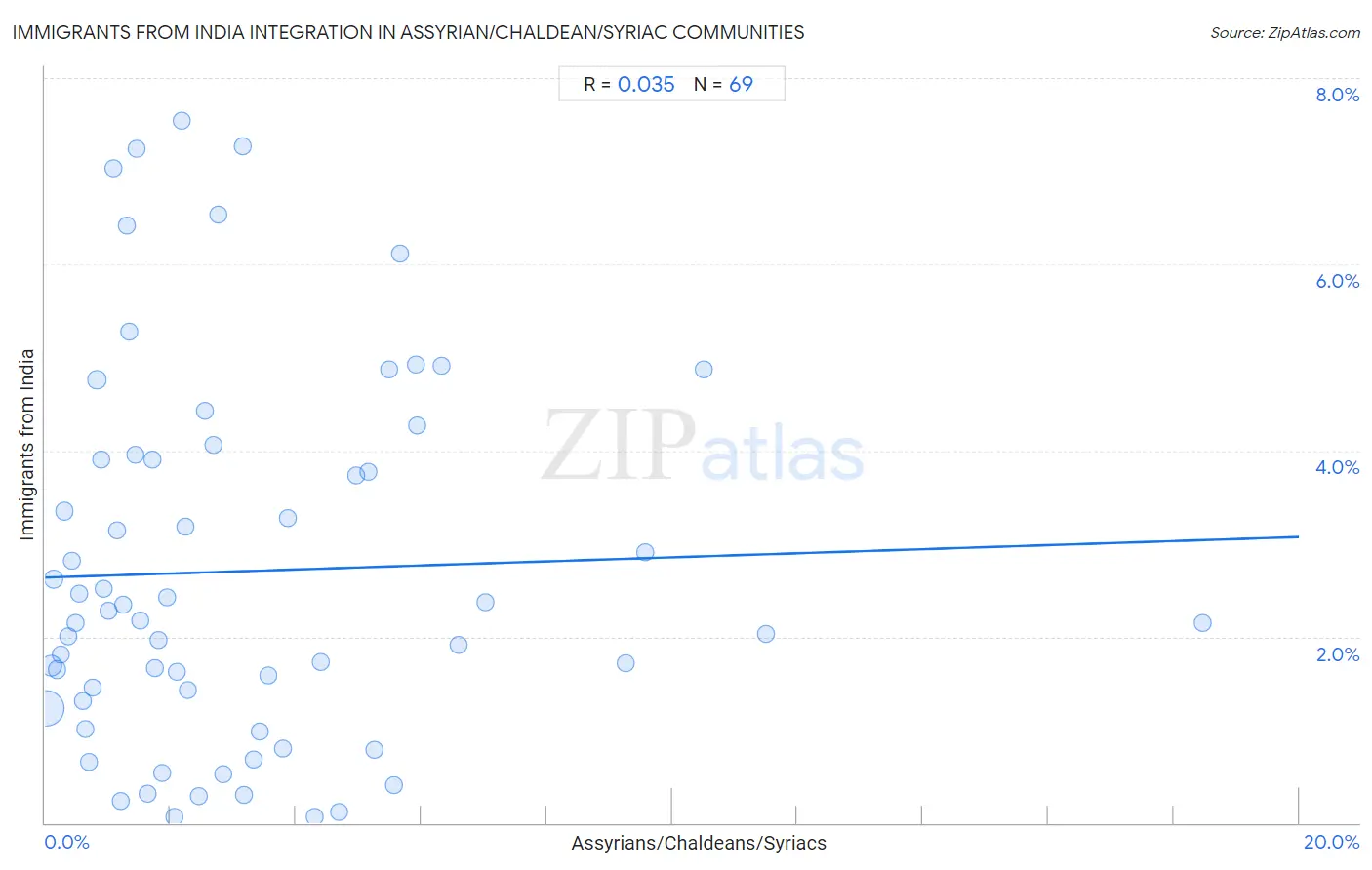
Assyrian/Chaldean/Syriac vs Immigrants from India Income
When considering income, the most significant differences between Assyrian/Chaldean/Syriac and Immigrants from India communities in the United States are seen in median male earnings ($58,437 compared to $74,207, a difference of 27.0%), median earnings ($48,304 compared to $60,648, a difference of 25.6%), and median female earnings ($39,159 compared to $48,292, a difference of 23.3%). Conversely, both communities are more comparable in terms of wage/income gap (31.0% compared to 31.5%, a difference of 1.7%), householder income under 25 years ($65,329 compared to $59,914, a difference of 9.0%), and householder income over 65 years ($64,108 compared to $72,804, a difference of 13.6%).

| Income Metric | Assyrian/Chaldean/Syriac | Immigrants from India |
| Per Capita Income | Excellent $45,195 | Exceptional $55,268 |
| Median Family Income | Exceptional $109,622 | Exceptional $134,028 |
| Median Household Income | Exceptional $91,991 | Exceptional $113,009 |
| Median Earnings | Exceptional $48,304 | Exceptional $60,648 |
| Median Male Earnings | Exceptional $58,437 | Exceptional $74,207 |
| Median Female Earnings | Fair $39,159 | Exceptional $48,292 |
| Householder Age | Under 25 years | Exceptional $65,329 | Exceptional $59,914 |
| Householder Age | 25 - 44 years | Exceptional $101,936 | Exceptional $124,238 |
| Householder Age | 45 - 64 years | Exceptional $110,201 | Exceptional $132,488 |
| Householder Age | Over 65 years | Exceptional $64,108 | Exceptional $72,804 |
| Wage/Income Gap | Tragic 31.0% | Tragic 31.5% |
Assyrian/Chaldean/Syriac vs Immigrants from India Poverty
When considering poverty, the most significant differences between Assyrian/Chaldean/Syriac and Immigrants from India communities in the United States are seen in receiving food stamps (10.6% compared to 7.4%, a difference of 43.7%), married-couple family poverty (4.9% compared to 3.6%, a difference of 34.5%), and child poverty among boys under 16 (13.6% compared to 10.9%, a difference of 25.5%). Conversely, both communities are more comparable in terms of single mother poverty (23.8% compared to 23.8%, a difference of 0.020%), single female poverty (17.0% compared to 16.8%, a difference of 0.83%), and seniors poverty over the age of 75 (10.7% compared to 10.4%, a difference of 2.5%).
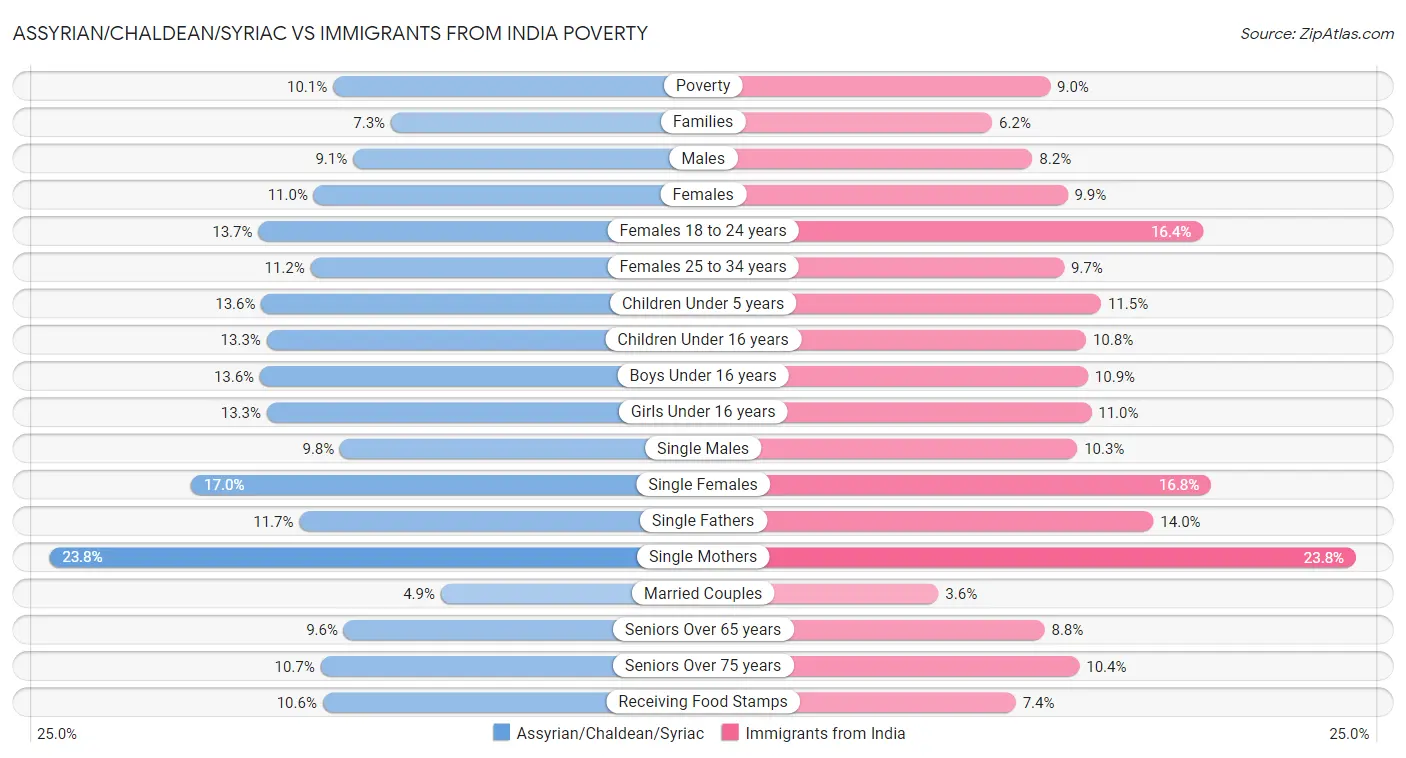
| Poverty Metric | Assyrian/Chaldean/Syriac | Immigrants from India |
| Poverty | Exceptional 10.1% | Exceptional 9.0% |
| Families | Exceptional 7.3% | Exceptional 6.2% |
| Males | Exceptional 9.1% | Exceptional 8.2% |
| Females | Exceptional 11.0% | Exceptional 9.9% |
| Females 18 to 24 years | Exceptional 13.7% | Exceptional 16.4% |
| Females 25 to 34 years | Exceptional 11.2% | Exceptional 9.7% |
| Children Under 5 years | Exceptional 13.6% | Exceptional 11.5% |
| Children Under 16 years | Exceptional 13.3% | Exceptional 10.8% |
| Boys Under 16 years | Exceptional 13.6% | Exceptional 10.9% |
| Girls Under 16 years | Exceptional 13.3% | Exceptional 11.0% |
| Single Males | Exceptional 9.8% | Exceptional 10.3% |
| Single Females | Exceptional 17.0% | Exceptional 16.8% |
| Single Fathers | Exceptional 11.7% | Exceptional 14.0% |
| Single Mothers | Exceptional 23.8% | Exceptional 23.8% |
| Married Couples | Excellent 4.9% | Exceptional 3.6% |
| Seniors Over 65 years | Exceptional 9.6% | Exceptional 8.8% |
| Seniors Over 75 years | Exceptional 10.7% | Exceptional 10.4% |
| Receiving Food Stamps | Exceptional 10.6% | Exceptional 7.4% |
Assyrian/Chaldean/Syriac vs Immigrants from India Unemployment
When considering unemployment, the most significant differences between Assyrian/Chaldean/Syriac and Immigrants from India communities in the United States are seen in unemployment among seniors over 75 years (11.1% compared to 8.2%, a difference of 34.0%), unemployment among ages 25 to 29 years (7.3% compared to 5.7%, a difference of 28.6%), and unemployment among ages 45 to 54 years (4.7% compared to 3.9%, a difference of 20.9%). Conversely, both communities are more comparable in terms of unemployment among ages 65 to 74 years (5.1% compared to 5.1%, a difference of 0.090%), unemployment among ages 60 to 64 years (4.5% compared to 4.6%, a difference of 0.74%), and unemployment among ages 20 to 24 years (9.9% compared to 9.7%, a difference of 2.0%).
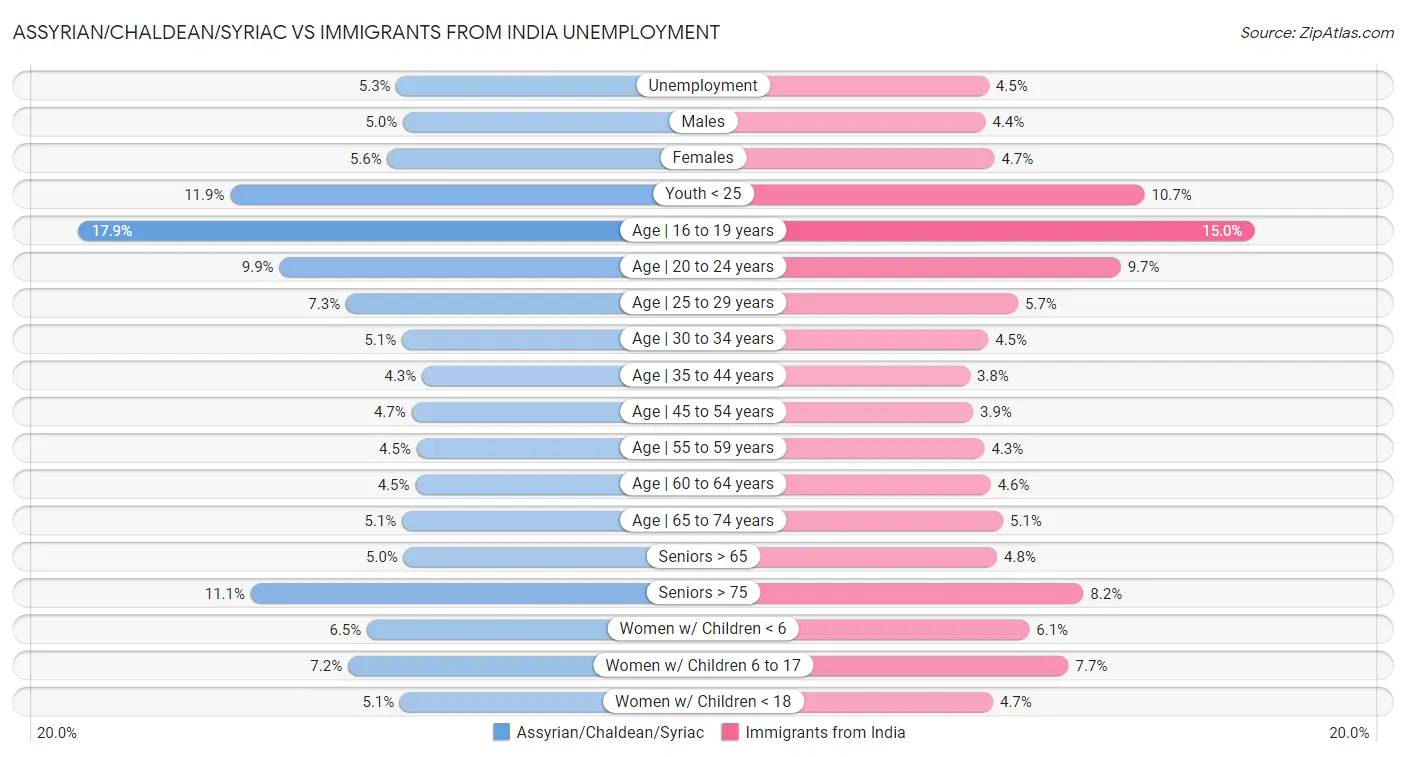
| Unemployment Metric | Assyrian/Chaldean/Syriac | Immigrants from India |
| Unemployment | Fair 5.3% | Exceptional 4.5% |
| Males | Exceptional 5.0% | Exceptional 4.4% |
| Females | Tragic 5.6% | Exceptional 4.7% |
| Youth < 25 | Tragic 11.9% | Exceptional 10.7% |
| Age | 16 to 19 years | Fair 17.9% | Exceptional 15.0% |
| Age | 20 to 24 years | Exceptional 9.9% | Exceptional 9.7% |
| Age | 25 to 29 years | Tragic 7.3% | Exceptional 5.7% |
| Age | 30 to 34 years | Exceptional 5.1% | Exceptional 4.5% |
| Age | 35 to 44 years | Exceptional 4.3% | Exceptional 3.8% |
| Age | 45 to 54 years | Tragic 4.7% | Exceptional 3.9% |
| Age | 55 to 59 years | Exceptional 4.5% | Exceptional 4.3% |
| Age | 60 to 64 years | Exceptional 4.5% | Exceptional 4.6% |
| Age | 65 to 74 years | Exceptional 5.1% | Exceptional 5.1% |
| Seniors > 65 | Exceptional 5.0% | Exceptional 4.8% |
| Seniors > 75 | Tragic 11.1% | Exceptional 8.2% |
| Women w/ Children < 6 | Exceptional 6.5% | Exceptional 6.1% |
| Women w/ Children 6 to 17 | Exceptional 7.2% | Exceptional 7.7% |
| Women w/ Children < 18 | Exceptional 5.1% | Exceptional 4.7% |
Assyrian/Chaldean/Syriac vs Immigrants from India Labor Participation
When considering labor participation, the most significant differences between Assyrian/Chaldean/Syriac and Immigrants from India communities in the United States are seen in in labor force | age 16-19 (38.3% compared to 35.0%, a difference of 9.3%), in labor force | age > 16 (64.0% compared to 67.6%, a difference of 5.6%), and in labor force | age 30-34 (83.2% compared to 85.2%, a difference of 2.4%). Conversely, both communities are more comparable in terms of in labor force | age 25-29 (84.7% compared to 85.7%, a difference of 1.2%), in labor force | age 35-44 (84.0% compared to 85.3%, a difference of 1.5%), and in labor force | age 45-54 (83.2% compared to 84.7%, a difference of 1.8%).

| Labor Participation Metric | Assyrian/Chaldean/Syriac | Immigrants from India |
| In Labor Force | Age > 16 | Tragic 64.0% | Exceptional 67.6% |
| In Labor Force | Age 20-64 | Fair 79.4% | Exceptional 81.3% |
| In Labor Force | Age 16-19 | Exceptional 38.3% | Tragic 35.0% |
| In Labor Force | Age 20-24 | Exceptional 75.9% | Tragic 74.4% |
| In Labor Force | Age 25-29 | Average 84.7% | Exceptional 85.7% |
| In Labor Force | Age 30-34 | Tragic 83.2% | Exceptional 85.2% |
| In Labor Force | Age 35-44 | Tragic 84.0% | Exceptional 85.3% |
| In Labor Force | Age 45-54 | Exceptional 83.2% | Exceptional 84.7% |
Assyrian/Chaldean/Syriac vs Immigrants from India Family Structure
When considering family structure, the most significant differences between Assyrian/Chaldean/Syriac and Immigrants from India communities in the United States are seen in family households with children (28.1% compared to 31.0%, a difference of 10.5%), single mother households (4.8% compared to 5.1%, a difference of 5.5%), and divorced or separated (10.6% compared to 10.1%, a difference of 5.0%). Conversely, both communities are more comparable in terms of family households (68.2% compared to 67.4%, a difference of 1.1%), average family size (3.24 compared to 3.21, a difference of 1.1%), and married-couple households (51.8% compared to 52.7%, a difference of 1.8%).

| Family Structure Metric | Assyrian/Chaldean/Syriac | Immigrants from India |
| Family Households | Exceptional 68.2% | Exceptional 67.4% |
| Family Households with Children | Exceptional 28.1% | Exceptional 31.0% |
| Married-couple Households | Exceptional 51.8% | Exceptional 52.7% |
| Average Family Size | Good 3.24 | Poor 3.21 |
| Single Father Households | Exceptional 2.0% | Exceptional 1.9% |
| Single Mother Households | Exceptional 4.8% | Exceptional 5.1% |
| Currently Married | Exceptional 50.8% | Exceptional 51.8% |
| Divorced or Separated | Exceptional 10.6% | Exceptional 10.1% |
| Births to Unmarried Women | Exceptional 22.0% | Exceptional 22.9% |
Assyrian/Chaldean/Syriac vs Immigrants from India Vehicle Availability
When considering vehicle availability, the most significant differences between Assyrian/Chaldean/Syriac and Immigrants from India communities in the United States are seen in no vehicles in household (7.0% compared to 8.2%, a difference of 17.0%), 4 or more vehicles in household (7.2% compared to 6.3%, a difference of 12.9%), and 3 or more vehicles in household (21.7% compared to 20.2%, a difference of 7.5%). Conversely, both communities are more comparable in terms of 1 or more vehicles in household (93.0% compared to 91.9%, a difference of 1.3%), 2 or more vehicles in household (60.5% compared to 59.3%, a difference of 2.1%), and 3 or more vehicles in household (21.7% compared to 20.2%, a difference of 7.5%).

| Vehicle Availability Metric | Assyrian/Chaldean/Syriac | Immigrants from India |
| No Vehicles Available | Exceptional 7.0% | Exceptional 8.2% |
| 1+ Vehicles Available | Exceptional 93.0% | Exceptional 91.9% |
| 2+ Vehicles Available | Exceptional 60.5% | Exceptional 59.3% |
| 3+ Vehicles Available | Exceptional 21.7% | Excellent 20.2% |
| 4+ Vehicles Available | Exceptional 7.2% | Average 6.3% |
Assyrian/Chaldean/Syriac vs Immigrants from India Education Level
When considering education level, the most significant differences between Assyrian/Chaldean/Syriac and Immigrants from India communities in the United States are seen in doctorate degree (1.7% compared to 2.8%, a difference of 71.3%), no schooling completed (2.5% compared to 1.7%, a difference of 41.9%), and master's degree (15.8% compared to 22.3%, a difference of 41.0%). Conversely, both communities are more comparable in terms of nursery school (97.6% compared to 98.3%, a difference of 0.76%), kindergarten (97.5% compared to 98.3%, a difference of 0.76%), and 1st grade (97.5% compared to 98.2%, a difference of 0.76%).
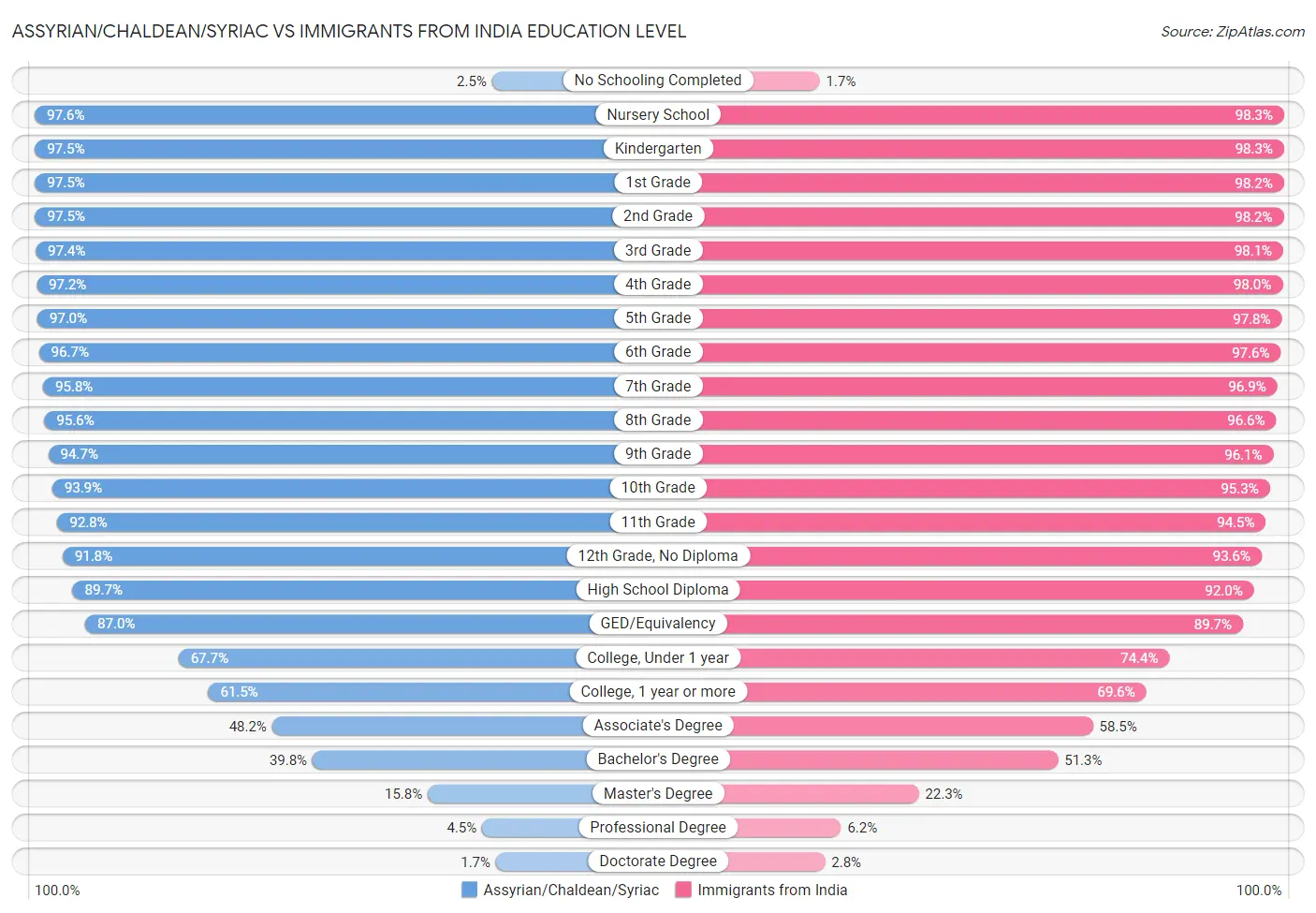
| Education Level Metric | Assyrian/Chaldean/Syriac | Immigrants from India |
| No Schooling Completed | Tragic 2.5% | Exceptional 1.7% |
| Nursery School | Tragic 97.6% | Exceptional 98.3% |
| Kindergarten | Tragic 97.5% | Exceptional 98.3% |
| 1st Grade | Tragic 97.5% | Exceptional 98.2% |
| 2nd Grade | Tragic 97.5% | Exceptional 98.2% |
| 3rd Grade | Tragic 97.4% | Exceptional 98.1% |
| 4th Grade | Tragic 97.2% | Exceptional 98.0% |
| 5th Grade | Tragic 97.0% | Exceptional 97.8% |
| 6th Grade | Tragic 96.7% | Exceptional 97.6% |
| 7th Grade | Fair 95.8% | Exceptional 96.9% |
| 8th Grade | Fair 95.6% | Exceptional 96.6% |
| 9th Grade | Fair 94.7% | Exceptional 96.1% |
| 10th Grade | Good 93.9% | Exceptional 95.3% |
| 11th Grade | Excellent 92.8% | Exceptional 94.5% |
| 12th Grade, No Diploma | Excellent 91.8% | Exceptional 93.6% |
| High School Diploma | Excellent 89.7% | Exceptional 92.0% |
| GED/Equivalency | Exceptional 87.0% | Exceptional 89.7% |
| College, Under 1 year | Exceptional 67.7% | Exceptional 74.4% |
| College, 1 year or more | Exceptional 61.5% | Exceptional 69.6% |
| Associate's Degree | Excellent 48.2% | Exceptional 58.5% |
| Bachelor's Degree | Excellent 39.8% | Exceptional 51.3% |
| Master's Degree | Excellent 15.8% | Exceptional 22.3% |
| Professional Degree | Good 4.5% | Exceptional 6.2% |
| Doctorate Degree | Tragic 1.7% | Exceptional 2.8% |
Assyrian/Chaldean/Syriac vs Immigrants from India Disability
When considering disability, the most significant differences between Assyrian/Chaldean/Syriac and Immigrants from India communities in the United States are seen in self-care disability (2.8% compared to 2.0%, a difference of 41.0%), ambulatory disability (6.4% compared to 4.8%, a difference of 34.5%), and hearing disability (3.3% compared to 2.5%, a difference of 31.5%). Conversely, both communities are more comparable in terms of cognitive disability (16.2% compared to 15.9%, a difference of 1.8%), disability age under 5 (1.1% compared to 1.0%, a difference of 4.7%), and disability age over 75 (49.1% compared to 45.2%, a difference of 8.6%).
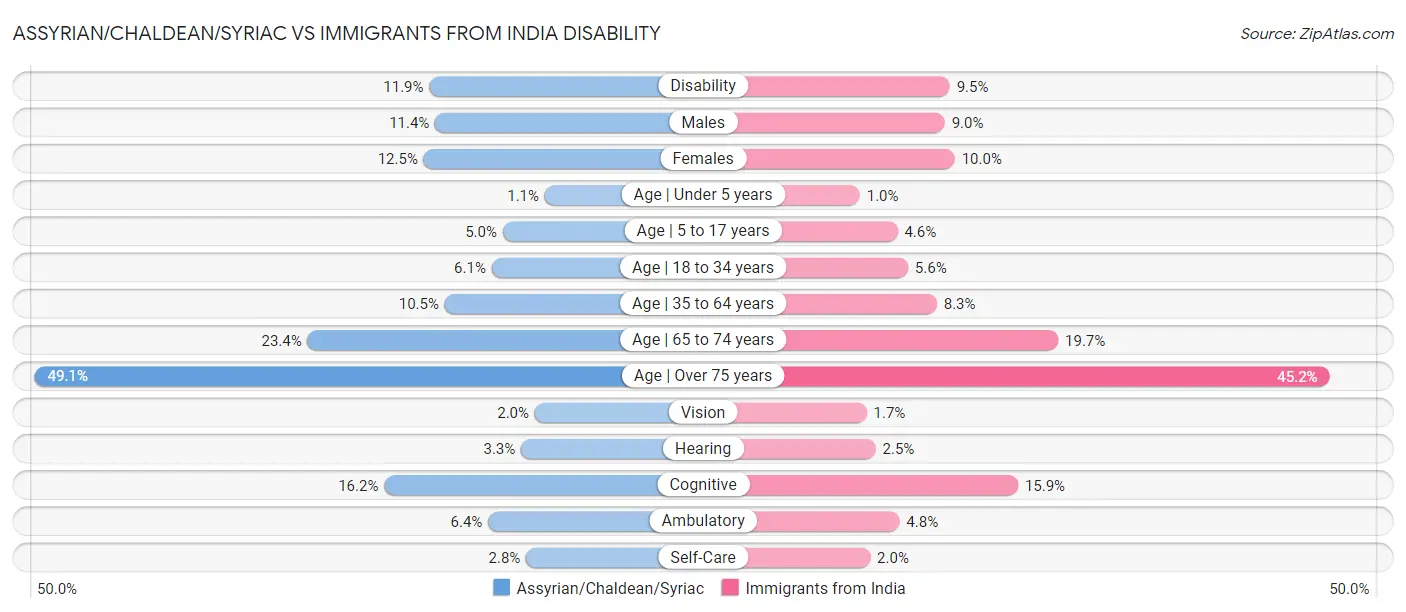
| Disability Metric | Assyrian/Chaldean/Syriac | Immigrants from India |
| Disability | Poor 11.9% | Exceptional 9.5% |
| Males | Fair 11.4% | Exceptional 9.0% |
| Females | Tragic 12.5% | Exceptional 10.0% |
| Age | Under 5 years | Exceptional 1.1% | Exceptional 1.0% |
| Age | 5 to 17 years | Exceptional 5.0% | Exceptional 4.6% |
| Age | 18 to 34 years | Exceptional 6.1% | Exceptional 5.6% |
| Age | 35 to 64 years | Exceptional 10.5% | Exceptional 8.3% |
| Age | 65 to 74 years | Average 23.4% | Exceptional 19.7% |
| Age | Over 75 years | Tragic 49.1% | Exceptional 45.2% |
| Vision | Exceptional 2.0% | Exceptional 1.7% |
| Hearing | Tragic 3.3% | Exceptional 2.5% |
| Cognitive | Exceptional 16.2% | Exceptional 15.9% |
| Ambulatory | Tragic 6.4% | Exceptional 4.8% |
| Self-Care | Tragic 2.8% | Exceptional 2.0% |